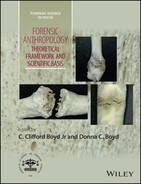Book Description
Provides comprehensive coverage of everything that students and practitioners need to know about working in the field of forensic anthropology
Forensic anthropology has been plagued by questions of scientific validity and rigor despite its acceptance as a section in the American Academy of Forensic Sciences nearly half a century ago. Critics have viewed it as a laboratory-based applied subfield of biological anthropology, and characterised it as emphasising methodology over theory. This book shows that these views are not only antiquated, but inadequate and inaccurate.
Forensic Anthropology: Theoretical Framework and Scientific Basis introduces readers to all of the theoretical and scientific foundations of forensic anthropology — beginning with how it was influenced by the early theoretical approaches of Tyler, Morgan, Spencer and Darwin. It instructs on how modern forensic science relies on an interdisciplinary approach — with research being conducted in the fields of archaeology, physics, geology and other disciplines. This modern approach to theory in forensic anthropology is presented through the introduction and discussion of Foundational, Interpretive and Methodological theories. Sections cover: Bias and Objectivity in Forensic Anthropology Theory and Practice; The Theory and Science Behind Biological Profile and Personal Identification; Scientific Foundation for Interpretations of Antemortem, Perimortem, and Postmortem Processes; and Interdisciplinary Influences, Legal Ramifications and Future Directions.
- Illustrates important aspects of the theory building process and reflects methods for strengthening the scientific framework of forensic anthropology as a discipline
- Inspired by the “Application of Theory to Forensic Anthropology” symposium presented at the 67th annual meeting of the American Academy of Forensic Sciences
- Chapters written by experts in the field who were presenters at the symposium
Forensic Anthropology: Theoretical Framework and Scientific Basis is ideal for university courses in anthropological science, forensic science, criminal science and forensic archaeology.
Table of Contents
- Cover
- Title Page
- About the Editors
- Notes on contributors
- Foreword
- Series preface
- Acknowledgments
- CHAPTER 1: The theoretical and scientific foundations of forensic anthropology
- PART 1: Bias and objectivity in forensic anthropology theory and practice
- PART 2: The theory and science behind biological profile and personal identification
- CHAPTER 5: From Blumenbach to Howells: The slow, painful emergence of theory through forensic race estimation
- CHAPTER 6: The application of theory in skeletal age estimation
- CHAPTER 7: Theory and histological methods
- CHAPTER 8: Forensic applications of isotope landscapes (“isoscapes”): A tool for predicting region‐of‐origin in forensic anthropology cases
- 8.1 Introduction
- 8.2 What are isotopes?
- 8.3 Why do isotope compositions of human tissues differ?
- 8.4 How do we interpret isotope data collected for forensic human identification?
- 8.5 Examples of the application of isotope analysis to unidentified remains
- 8.6 What are the future applications of isotope analysis?
- Acknowledgments
- References
- PART 3: Scientific foundation for interpretations of antemortem, perimortem, and postmortem processes
- CHAPTER 9: The anatomical basis for fracture repair: Recognition of the healing continuum and its forensic applications to investigations of pediatric and elderly abuse
- 9.1 Introduction: Diagnosing pediatric and elderly non‐accidental injury
- 9.2 Theoretical basis for fracture healing and TSI estimation
- 9.3 Anatomical basis for fracture healing
- 9.4 Factors affecting the rate of bone healing
- 9.5 Fracture healing stages and dating systems
- 9.6 A new model for fracture repair
- 9.7 Expanding and refining TSI estimation through the Antemortem Fracture Archive
- 9.8 Theory and the future of TSI estimation
- References
- Appendix A: Major fracture repair stages and TSI estimations
- CHAPTER 10: Theoretical foundation of child abuse
- CHAPTER 11: Bone trauma analysis in a forensic setting: Theoretical basis and a practical approach for evaluation
- CHAPTER 12: Thinking outside the box: Theory and innovation in sharp trauma analysis
- 12.1 Introduction
- 12.2 Transfer of evidence
- 12.3 Theory connections
- 12.4 The human skeleton as transfer evidence
- 12.5 A primer on saws and dismemberment
- 12.6 Geographic information system
- 12.7 Applications of GIS in forensic anthropology and human osteology
- 12.8 GIS: innovation in cut mark striation interpretation
- 12.9 Locard and the twenty‐first century: It’s all a matter of scale
- References
- CHAPTER 13: The forensic anthropologist as broker for cross‐disciplinary taphonomic research related to estimating the postmortem interval in medicolegal death investigations
- 13.1 Introduction
- 13.2 Taphonomy and taphonomic theory
- 13.3 Forensic taphonomy
- 13.4 Taphonomy and the estimation of time since death
- 13.5 The necrobiome
- 13.6 Cross‐disciplinary research
- 13.7 Overcoming barriers to cross‐disciplinary research
- 13.8 Forensic anthropologists as brokers for unified theories in forensic taphonomy
- 13.9 Conclusions
- Acknowledgments
- References
- CHAPTER 9: The anatomical basis for fracture repair: Recognition of the healing continuum and its forensic applications to investigations of pediatric and elderly abuse
- PART 4: Interdisciplinary influences, legal ramifications, and future directions
- CHAPTER 14: Archaeological inference and its application to forensic anthropology
- CHAPTER 15: Arrows of influence: The give and take of theory between forensic anthropology, archaeology, and geophysics
- 15.1 Introduction
- 15.2 Influences of archaeology on forensic anthropology
- 15.3 Influences of geophysics on forensic anthropology
- 15.4 “Backflow” to other disciplines: Site formation processes in archaeology
- 15.5 Backflow: Interpretation/understanding of geophysical signatures
- 15.6 Conclusion
- References
- CHAPTER 16: Forensic anthropology, scientific evidence, and the law: Why theory matters
- 16.1 Introduction: Theory in practice
- 16.2 Science and the law: The disconnect
- 16.3 Science and the law: Commonalities
- 16.4 Forensic anthropologists as expert witnesses
- 16.5 Admissibility of forensic anthropology evidence in the post‐Daubert world
- 16.6 The legal application of forensic anthropology: Why theory matters
- 16.7 Final comments
- Acknowledgments
- References
- CHAPTER 17: Epilogue: Theory and science in forensic anthropology: Avenues for further research and development
- Index
- End User License Agreement
